I. SEARCHING FOR THE ORIGIN OF THE SLAVS
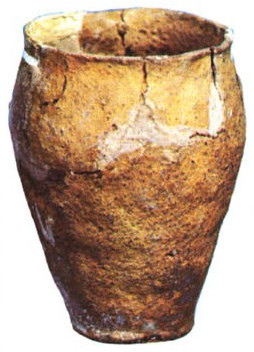
1. The Oldest Written Records 9
2. What Philology Can Prove 15
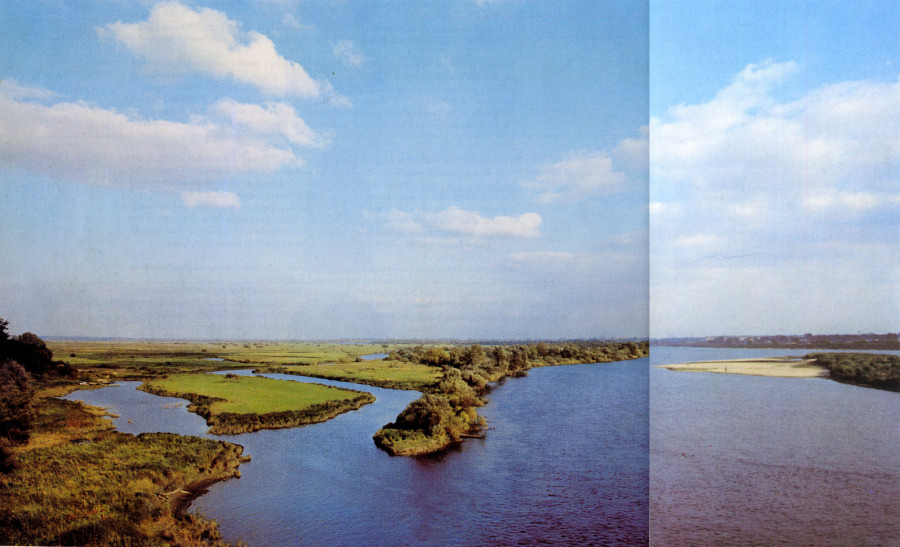
The river Vistula played an important role in the emergence of the Slavs as a people. Its river basin was inhabited from the first century B.C. to the early fifth century A. D. by the ethnically mixed Przeworsk culture, which included the Germans and the mysterious Venedi, who are considered the ancestors of the Slavs. The early Slavs emerged here at the end of the fifth century.
8
![]()
1. THE OLDEST WRITTEN RECORDS
It is an amazing fact that so little attention has been paid for so long to so large a section of the European population as that represented by the Slavs — roughly every third European is of Slav origin. Not a single mention of the existence of the Slavs can be found in the works of ancient historians and geographers until the time of the migration of nations, yet they described the entire known world of the time and left detailed records of, for example, the Germanic and the Celtic tribes. There are a number of reasons for this. Chief among these is that the Slav ethnogeny took place at a much later date than was the case of the Celts or the Germanic tribes. Furthermore, these processes were taking place beyond the sphere of interest of the ancient world — in the remote regions of Eastern Europe where even the more enterprising traders visited only on rare occasions. They were acquainted mainly with the southern parts of European Russia which they called Scythia or Sarmatia after the peoples living there. Greek colonies were founded along the northern shores of the Black Sea as early as in the seventh and sixth centuries B. C., and it is highly likely that the Greeks ventured further inland along the big rivers in search of trade. Bui barely any records exist of these early discoveries except a mention in the works of Hecataeus of Miletus.
In the fifth century B.C. Herodotus, the father of Greek historians, visited Scythia. He went no further than the town of Olbia and stayed at the mouth of the Dniester, but he learnt many facts about the nations living further north from local experts; these he recorded in the fourth book of his History (Histories apodexis). For long centuries his detailed description of Scythia provided the bare facts of what the ancients knew about Eastern Europe. Herodotus was aware that broad steppes lay in the southern parts crossed by a number of rivers and that boundless forests stretched further to the north. He knew the rivers that flow into the Black Sea: the Danube (Istros) with the Siret (Ordessos) and the Prut (Pyretos), the Dniester (Tyres), Bug (Hypanis) and Dnieper (Borysthenes). He was informed about the Don (Tanais) that flows into the Sea of Azov (Maiotis). He described the dramatic but unsuccessful expedition that the Persian King Darius undertook, towards the end of the sixth century, against the Scythians, a militant tribe
9
![]()
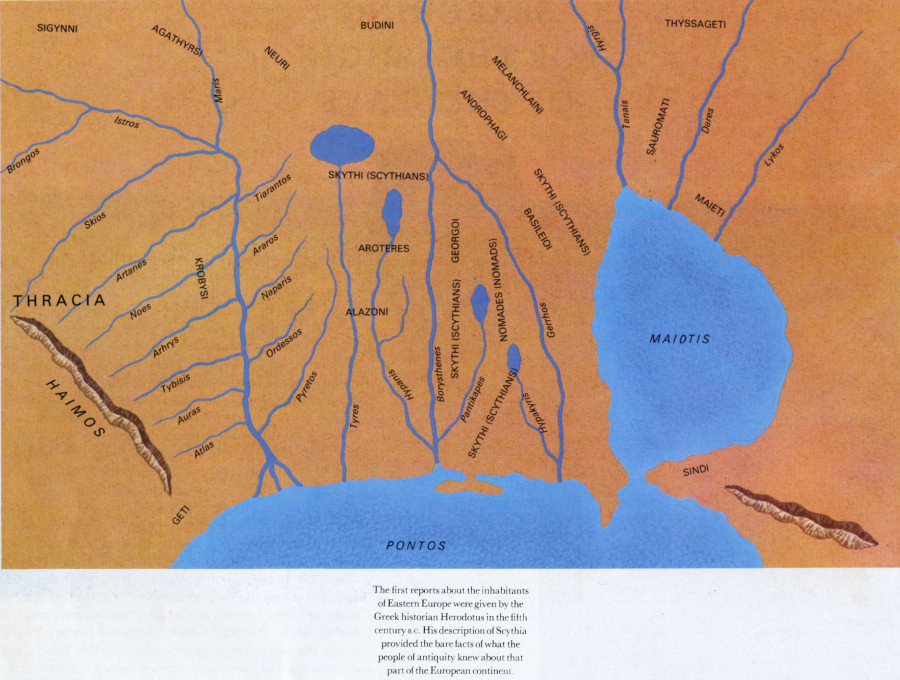
The first reports about the inhabitants of Eastern Europe were given by the Greek historian Herodotus in the fifth century B.C. His description of Scythia provided the bare facts of what the people of antiquity knew about that part of the European continent
of Iranian origin. Herodotus also knew of other tribes who had settled to the west, north and east of the Scythians, and helped them in the guerrilla war against Darius. To the west were the Agathyrsi, a tribe that was probably of Thracian origin, "loving luxury and gold", which they mined in Romanian Transylvania. To the north, between the upper Dniester and the middle Dnieper, lived the mysterious Neuri. Their name has survived in certain place-names in eastern Poland: the rivers Nura, Nurzec, and Nurland, the name for the entire region. The Neuri are therefore associated with the Slavs. According to Herodotus, they left their former homeland to escape large numbers of snakes. Their customs were similar to those of the Scythians, but at a certain time of the year they all turned into wolves. This report by Herodotus clearly refers to the belief in werewolves, which was widespread in Eastern Europe until the modern era. Between the middle course of the Dnieper and the Don lay the settlements of the cruel Androphagi (cannibals) and the nomad Melanchlaini, whose name derived from their habit of wearing black garments. To the north of these, probably already in the forests, and as eastern neighbours of the Neuri, lived the teeming nation of fair-haired and blue-eyed Budini, who likewise remain a mystery. They lived mainly by hunting and dressed in furs. They may have been a Finnic tribe, although they are sometimes mentioned in connection with the Slavs, for their name does have a Slavonic sound. Beyond these tribes, further north, Herodotus knew only of uninhabited regions; the tribes living to the east of the Don — the Thyssageti and Sauromati — are outside the scope of this work.
What remains open to discussion is the possible Slav origin of the Ploughmen Scythians (to be distinguished
10
![]()
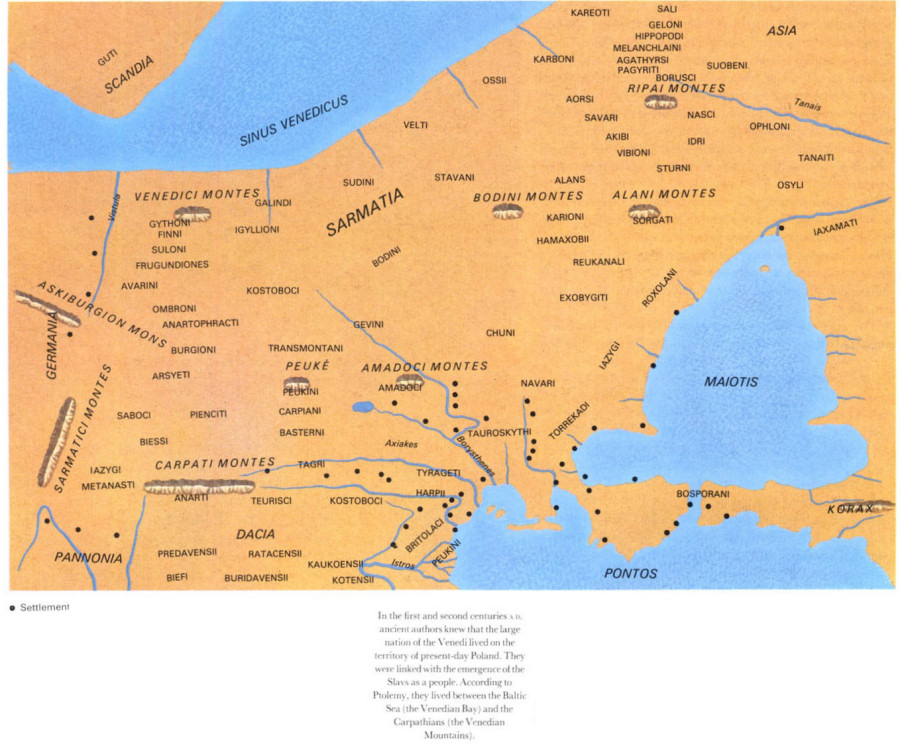
In the first and second centuries A. D. ancient authors knew that the large nation of the Venedi lived on the territory of present-day Poland. They were linked with the emergence of the Slavs as a people. According to Ptolemy, they lived between the Baltic Sea (the Venedian Bay) and the Carpathians (the Venedian Mountains).
from the Royal Scythians and the Nomad Scythians), Neuri and Budini. There is nothing to prove this, and the link between these tribes and the Slavs remains a matter of hypothesis.
This link may apply in the case of the large nation of the Venedi, who lived beyond the Vistula, between the Baltic Sea and the Carpathians. They are mentioned in the works of Roman and Greek writers of the first and second centuries A. D. Records exist in Pliny the Elder's Naturalis Historia of c. 77 and in the Germania by Tacitus of the year 98. They are also mentioned by Ptolemy the geographer, who died in 178.
Tacitus was at a loss as to whether to count the Venedi among the Germanic tribes or the Iranian Sarmatians. But since the Venedi moved on foot, built houses and used shields, in contrast to the nomad Sarmatians, who lived in their wagons, he considered them aligned with the Germanic tribes. This view has never been confirmed.
Valuable facts on the Venedi were supplied by Ptolemy, the outstanding mathematician, astronomer and geographer, who lived in Alexandria in the second century A.D. On his map he placed the Venedi to the east of the Vistula towards the Venedian Bay (probably a bay in the Baltic Sea between the mouths of the Vistula and the Memel), and they were spread as far as the Venedian Mountains (clearly the Carpathians). In view of Ptolemy's records scholars looking for settlements of the ancient Slavs have been concentrating largely on the Venedi. For until the sixth century their name was used for the early Slavs, and it has survived to this day in the German name for the Slavs — die Wenden. But it is not entirely clear whether the ancient Venedi can be identified with the Slavs. Their name is not of Slav origin
11
![]()
— it may derive from the Celtic vindos, "the white" (and survives, for example, in the ancient name for Vienna Vindobona). Or it may come from the Proto-Indo-European ven'd. For that reason many scholars are of the opinion that the Venedi may have been part of the Celts or Illyrians, who later migrated further south into the Mediterranean region. (From this we get, for instance, the name of Venice.) Others, on the contrary, believe that the Venedi were an unknown European people, who later merged with the Slavs and gave them their own name.
On Ptolemy's map we can find one other ethnic term which remains a puzzle to historians and ethnographers: the Suobeni, which many believe to mean the Slovene. Unfortunately, Ptolemy reveals only that this tribe lived in northern Scythia by the side of the Alans and Alanorsi. These statements have never been confirmed.
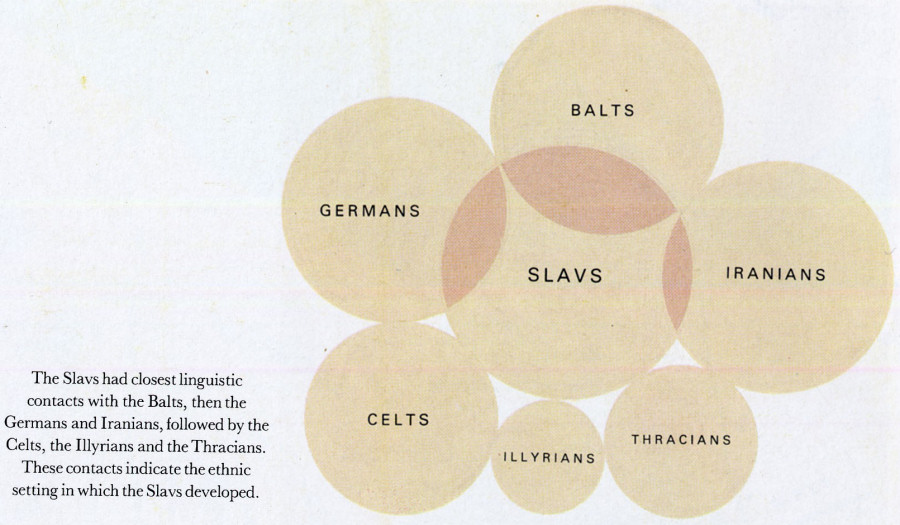
The Slavs had closest linguistic contacts with the Balts, then the Germans and Iranians, followed by the Celts, the Illyrians and the Thracians. These contacts indicate the ethnic setting in which the Slavs developed.
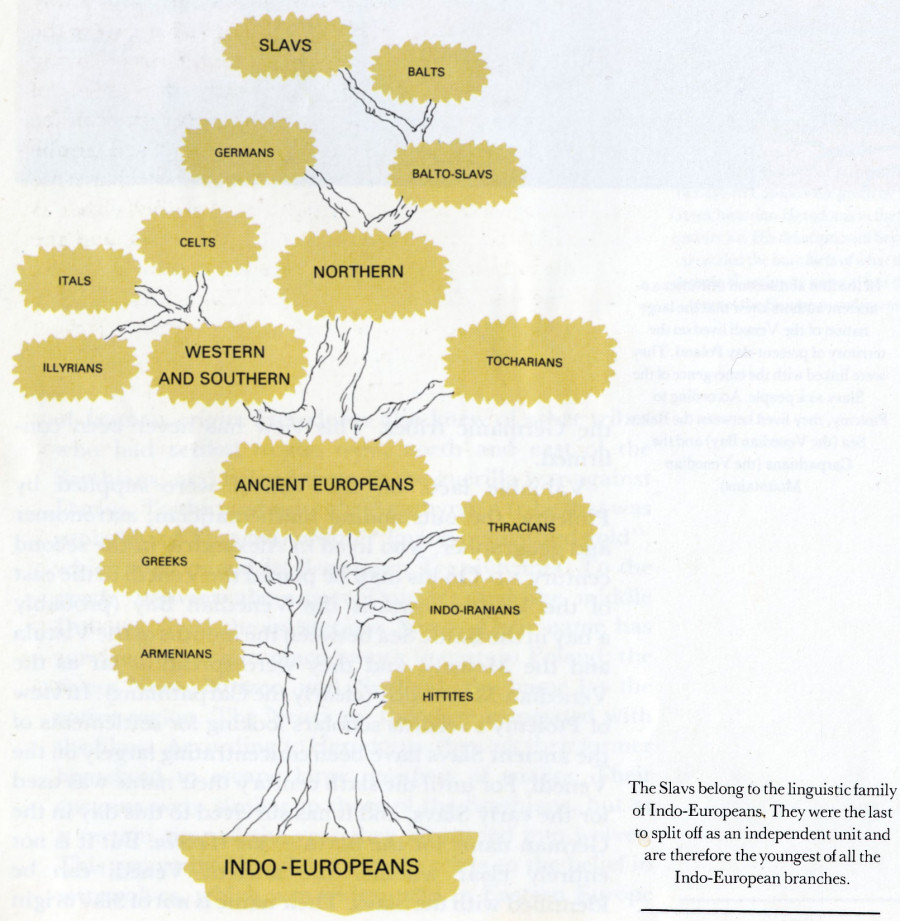
The Slavs belong to the linguistic family of Indo-Europeans, They were the last to split off as an independent unit and are therefore the youngest of all the Indo-European branches.
The mystery of the existence and location of the Slavs during Roman times is enhanced by the fact that the Romans never came into closer contact with Central and Eastern Europe, although they penetrated to the vicinity of later Slav settlements on several occasions, for example, under Emperor Augustus in 9 B.C., during the reign of Tiberius in the years A.D. 14—16 and at the time of Trajan (A.D. 98—117). The Romans' last successful attempt to break through into Central Europe was an expedition led by Marcus Aurelius (A.D. 161—180) against the Marcomanni and Quadi on the territory of Slovakia today. The Roman Emperor and philosopher sat on the banks of the Slovak river Hron and wrote his Meditations. He left an inscription on a rock at Trenčín in Slovakia, which to this day marks the Romans' most northerly inroad into Central Europe. But the Emperor failed to establish the province of Marcomannia, which was to have occupied the territory of present-day Czechoslovakia, or the province of Sarmatia, to cover the eastern parts of present-day Hungary, for he died at Vindobona (Vienna) in A. D. 180. In the following centuries the Roman Empire found itself on the defensive against its northerly neighbours until finally it succumbed to the influx of barbarians at the time of the migration of nations. Only its eastern parts, Byzantium, survived.
And at this point a new factor arrived on the scene — the Slavs, advancing in vast numbers into Central and South-Eastern Europe from the regions beyond the Carpathians. They are mentioned for the first time, and by their own name, by Pseudo-Caesarius Nazianus in his book Dialogi dating from the beginning of the sixth century. The main information on the Slavs in the sixth century was, however, provided by Procopius and Jordanes.
The Byzantine historian Procopius of Caesareia took part in the struggle of the Byzantines against the Germanic Goths and wrote a book about it. Among others, he describes the long migration of the Germanic Heruli in 512 from somewhere along the middle course
12
![]()
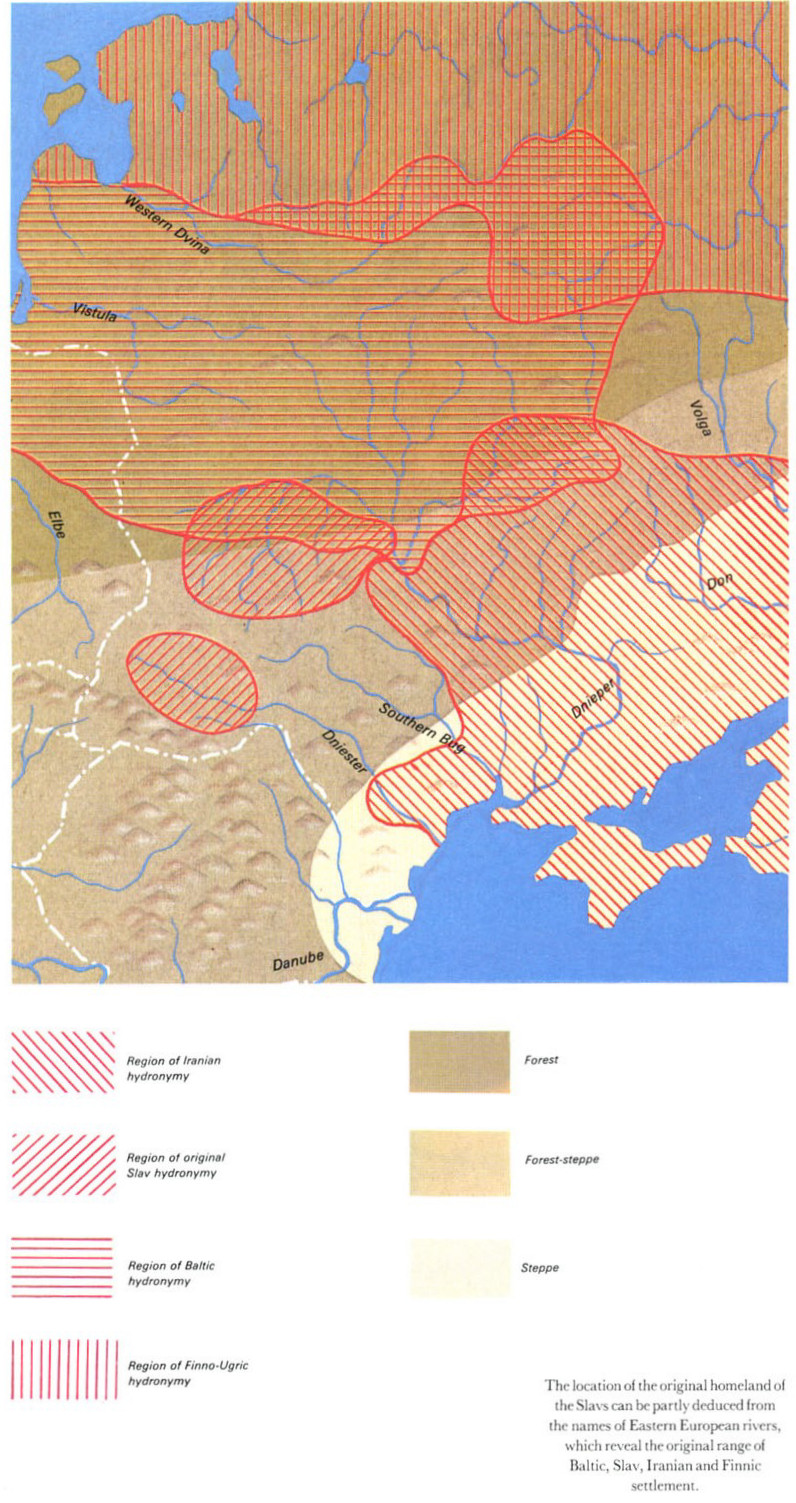
The location of the original homeland of the Slavs can be partly deduced from the names of Eastern European rivers, which reveal the original range of Baltic, Slav, Iranian and Finnic settlement.
of the Danube "traversing all Slavic nations" and across empty regions to the Varni in the Elbe valley, from where they returned to their original homeland in Scandinavia. Even though the exact route of their migration is not entirely clear, this report confirms that the Slavs were already in Central Europe at that time. But they did not occupy it completely; there were still "empty regions", that is, parts that had not yet been settled. Another report by Procopius relates the adventurous struggles of the Lombard Hildigis, who, in the course of a life full of vicissitudes, often found refuge among the Slavs. Since the Germanic Lombards at that time occupied the Danube valley of today's Austria and Hungary, and their enemies, the Gepids, lived along the river Tisza, we probably have to look for the settlements of Hildigis's Slavonic friends in the northern neighbourhood of the Lombards, that is, somewhere in the region where Slovakia and Moravia extend today. This means that by the first half of the sixth century the Slavs had already arrived there. But the report says nothing about when and from where they had come.
The report by Jordanes is not much more satisfactory cither, although he supplies further facts. He also wrote the history of the Goths, whom he knew from personal experience since he was in the services of Gunthigis, King of the Goths. He mentions the Slavs too, whom he calls Venedi or Venethi, as being a numerically large people settled over a vast area and divided into many tribes. The most important, according to him, were the Sclaveni and the Antes. The Sclaveni were living between the Vistula, the Dniester, the town of Novietunum and Lake Mursia. Novietunum can be identified with ancient Noviodunum in the Danube delta on the territory of Romania. What is not clear is the location of Lake Mursia. It might be identified either as Lake Balaton or the confluence of the Tisza and the Danube in Hungary, or possibly as the confluence of the Sava and the Danube in northern Yugoslavia. In any case, Jordanes depicts a moment when the Slavs had set out from their original homeland. The mysterious Antes — possibly an Iranian tribe that later became engulfed by the Slavs — lived somewhere between the Dnieper and the Dniester. In the seventh century they were defeated by the Avars and vanished.
Historical sources, in other words, only reveal that the Slavs entered European history as a unit in the sixth century. At that time they began to spread to their present settlements, but it is not clear where they had lived before and what their previous development had been. The relationship to the ancient Venedi is merely hypothetical. One can certainly not equate the Slavs with the Venedi.
13
![]()
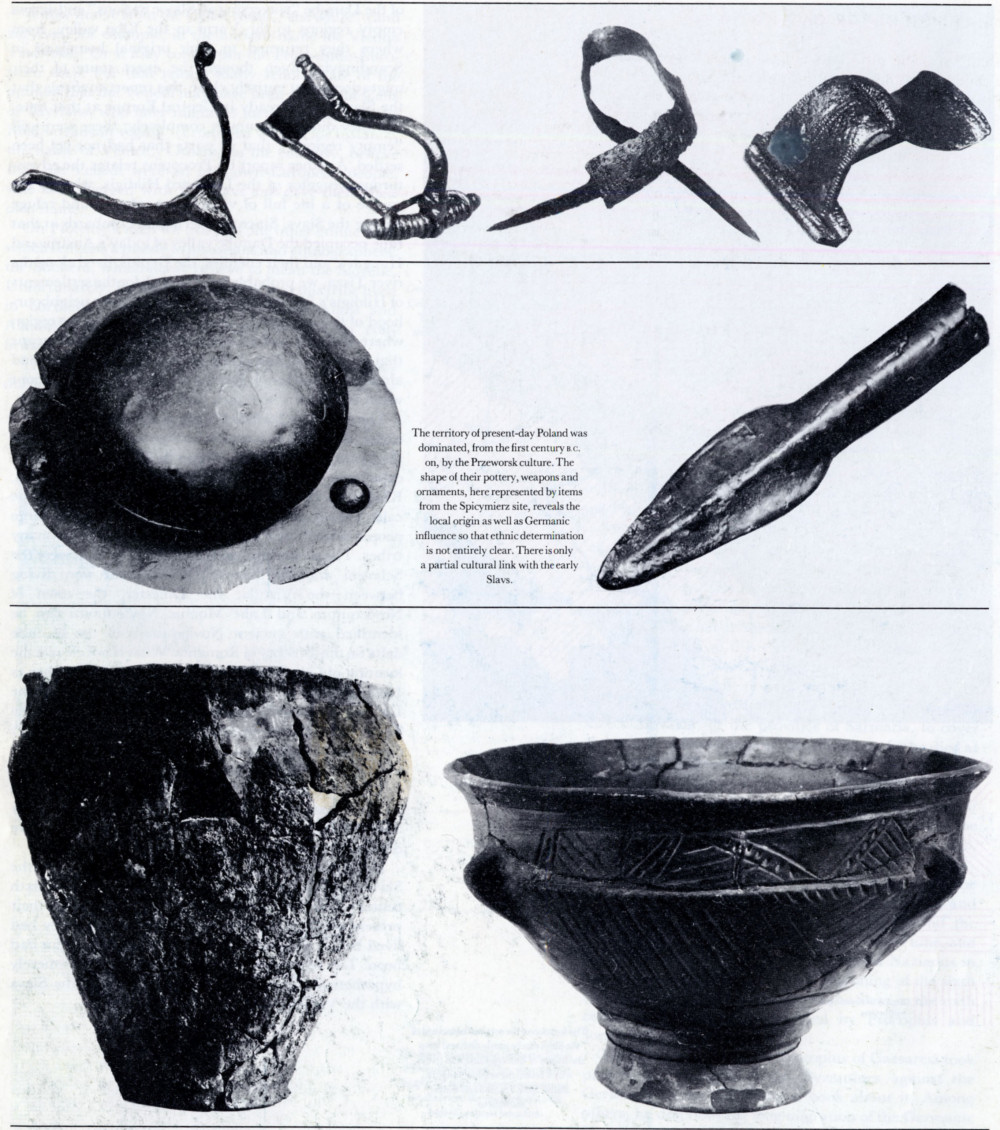
The territory of present-day Poland was dominated, from the first century B.C. on, by the Przeworsk culture. The shape of their pottery, weapons and ornaments, here represented by items from the Spicymierz site, reveals the local origin as well as Germanic influence so that ethnic determination is not entirely clear. There is only a partial cultural link with the early Slavs.
14
![]()
2. WHAT PHILOLOGY CAN PROVE
Along with the historians the philologists have made great efforts to delve into the secret of the origin of the Slavs. They approach the matter in two ways: the study of linguistic relations to neighbouring ethnic groups and the analysis of local names, especially hydronymy, the names of watercourses.
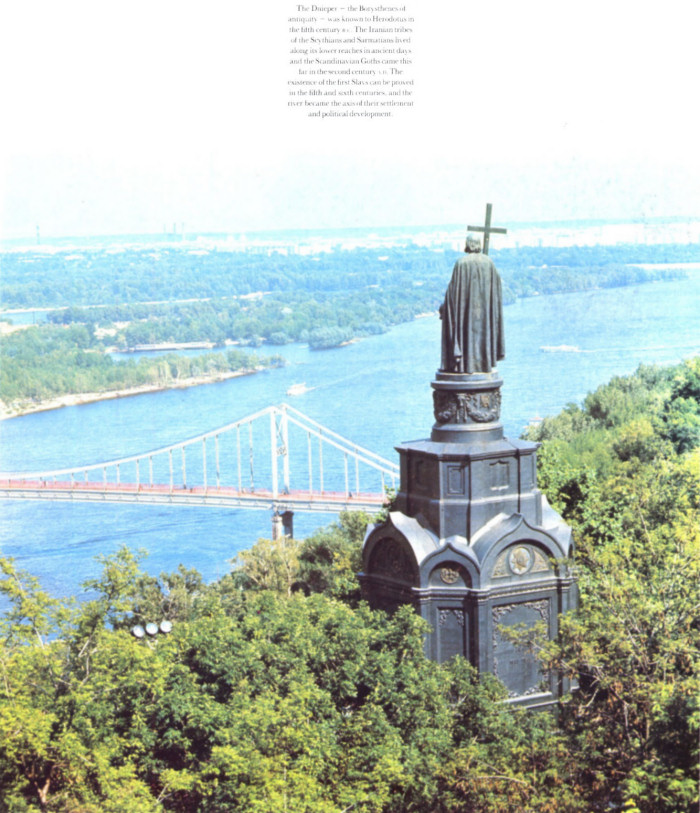
The Dnieper — the Borysthenes of antiquity — was known to Herodotus in the fifth century B.C. The Iranian tribes of the Scythians and Sarmatians lived along its lower reaches in ancient days and the Scandinavian Goths came this far in the second century A.D. The existence of the first Slavs can be proved in the fifth and sixth centuries, and the river became the axis of their settlement and political development.
Together with the Balts, Germans, Celts, Romans, Greeks, Albanians, Armenians, Iranians and Indians, the Slavs belong to the vast family of Indo-Europeans. In the past certain other groups had been members, who have since died out, such as the Hittites (Anatolians), Thracians, Illyrians and Tokharians. Philologists differ greatly in their views as to how the individual languages gradually developed from the originally almost unified Indo-European language, and individual stages of development are dated in a very relative and approximate manner. It would seem that the first to split off were the Hittites and the Indo-Iranian languages; the next phase saw the independent development of Greek, Armenian and Thracian, and gradually Italic, Celtic, Germanic and Illyrian, and lastly, and most likely, the unified Balto-Slavic, which later divided into Baltic and Slavonic. Views as to the stages of this development are not fully agreed upon, and there is no precise chronology.
15
![]()
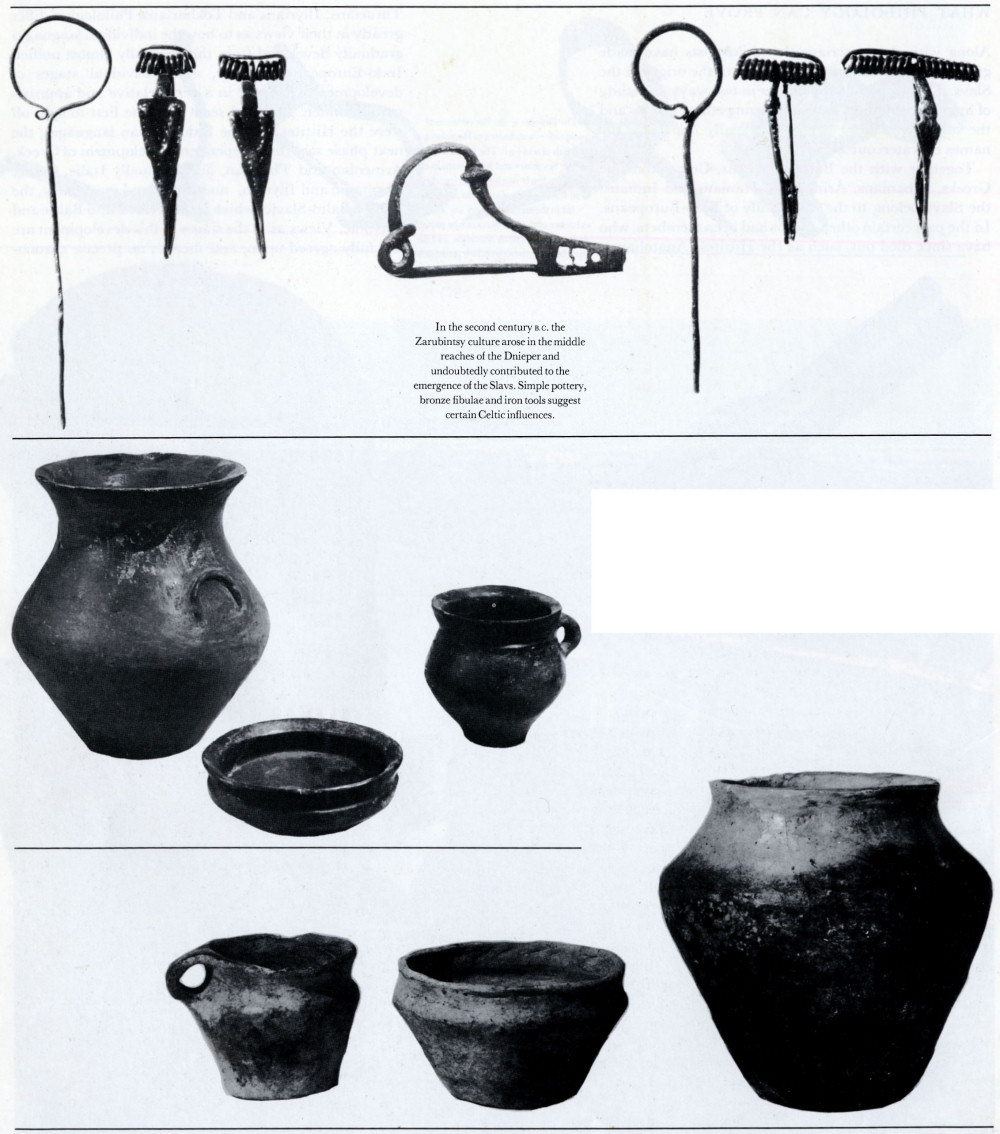
In the second century B.C. the Zarubintsy culture arose in the middle reaches of the Dnieper and undoubtedly contributed to the emergence of the Slavs. Simple pottery, bronze fibulae and iron tools suggest certain Celtic influences.
But one thing is clear: the Slavs as an ethnic unit were among the last to develop and are relatively the youngest of all Indo-European branches. For that reason the early Middle Ages knew only one Slavonic language (lingua slavica), which was spoken from the sixth to the ninth or tenth century by all Slavs from the Baltic to the Aegean Sea, and from the Elbe to the
16
![]()
Dnieper, with only minor dialectal deviations among the Western, Eastern and Southern Slavs.
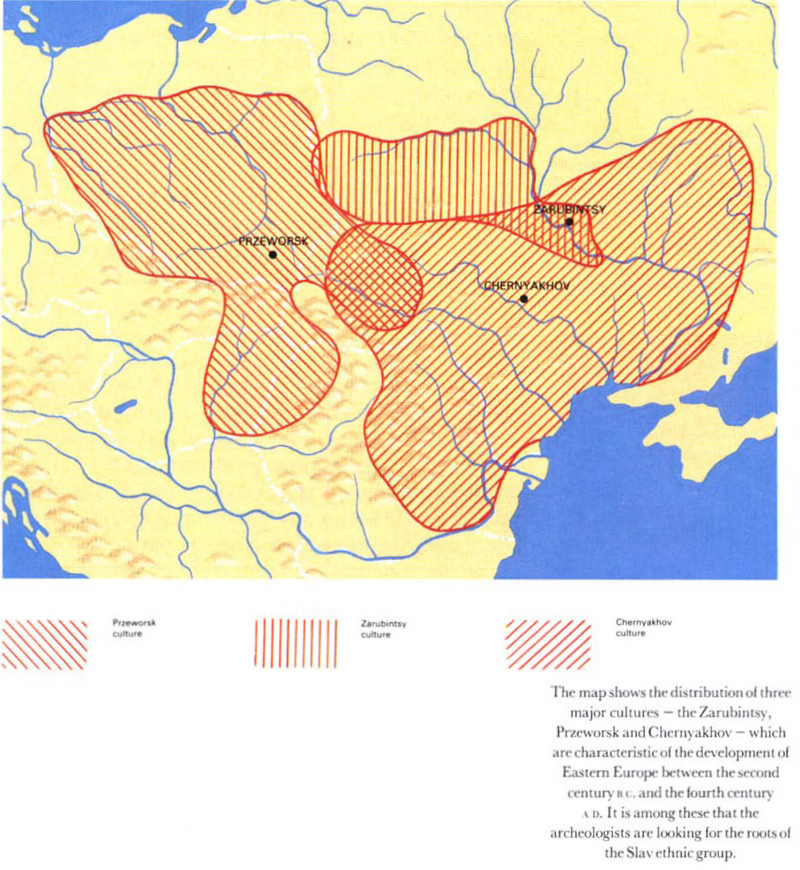
The map shows the distribution of three major cultures — the Zarubintsy, Przeworsk and Chernyakhov — which are characteristic of the development og Eastern Europe between the second century B.C. and the fourth century A.D. It is among these that the archeologists are looking for the roots of the Slav ethnic group.
After the consolidation of new settlements and the establishment of the first Slav states different national tongues began to develop, due to geographical, political and cultural differentiation. These languages are in use to this day. Altogether twelve languages formed, divided into three groups: (1) the Western Slav group: Polish, Lusatian, Polabian (a vanished tongue of the Slav tribes on the territory of East Germany today), Czech and Slovak; (2) the Eastern Slav group: Russian, Ukrainian and Byelorussian; (3) the Southern Slav group: Serbo-Croat, Slovene, Macedonian and Bulgarian. These languages became more differentiated in the twelfth and thirteenth centuries. But even before this happened, there existed a literary language of Church Slavonic — thanks to the mission of Constantine and Methodius, the apostles to the Slavs, in the ninth century. In Eastern Orthodox circles this Church Slavonic is used with local modifications to the present time. It is not known when the three major groups began to split up into separate groups of Eastern, Western and Southern. Some philologists assume there had been dialectal differences between them already in their original homeland. But it seems more likely that the differentiation took place after the Slav tribes had settled in different regions, lost contact with each other and came into touch with different cultures and languages in their new settlements, which brought about a differentiated development.
The degree of relationship of Slavonic languages to the other Indo-European languages varies. The greatest number of common features can be found with the Baltic languages: Lithuanian, Latvian and the now vanished Prussian and Yatvingian. This leads one to deduce that there had once been a common Balto-Slavic unit. Then there are links with the Germanic and Iranian languages, and certain elements are in common with Celtic, Illyrian and Thracian. In other words, the Slavonic language developed somewhere in between these ethnic units: the Baltic to the north, Germanic to the west, Iranian in the east and Celtic, Thracian and Illyrian in the south.
An analysis of ancient topographical names, especially those of rivers, helps in localization of the development of Slavonic languages. Pure Slavonic names are to be found mainly in the region between the Oder and the middle Dnieper, and linguists are all agreed in stressing the relatively archaic type of the names in the valley of the Oder and the Vistula. The hydronyms on the Pripyať and Dnieper rivers, by contrast, seem to be of a somewhat later date and provide proof that the Slavs migrated towards the east at a later stage. The problem is how to determine the time at which these local names came into existence as well as dating the oldest language contacts with the neighbouring ethnic groups. The Slavs had closest relations with the Balts, who, once upon a time, occupied a far larger area of Eastern Europe than today. Their heartland lay in the river basin of the Nieman, Pregel, upper Dnieper and Western Dvina. If we are to believe hydronyms, the original Baltic settlements reached much further east to the region between the Volga and the Oka, south-east to the Seim and south as far as the right bank of the Pripyať — that is, a region that was already firmly in Slav hands in the sixth century A.D. The present-day Baltic nations — the Lithuanians and Latvians — are, in other words, an insignificant fragment of a once large ethnic unit. In this respect their fate resembles that of the Celts. It can further be shown that the Balts had ancient linguistic connections with the Finns, Iranians and Thracians who complete the semi-circle to their north-east, east, and south-east. The Slavs, therefore, must have developed to the south and south-west of the Balts, and their western and northwestern neighbours can only have been Germanic tribes, who were closest to them linguistically after the Balts.
Philological research suggests that before the beginning of migration in the sixth century the Slavs must have occupied a region between the above mentioned ethnic groups, that is, north of the Carpathians, and somewhere between the middle course of the Dnieper and the river basins of the middle and upper Vistula and Oder.
17
![]()
3. WHAT ARCHEOLOGY HAS REVEALED
Since language provides few concrete facts in regard to the chronology of the oldest period, one must turn to archeology for help. In the last few decades archeologists have managed to trace and work out in increasingly fine detail the cultural development of the assumed Slavic homeland back to the Neolithic period. However, all attempts to prove that the Slavs already existed in the distant past remain a matter of speculation. The archeologists can easily distinguish individual cultural units and map their geographical spread, but they encounter insuperable barriers when trying to stipulate ethnic adherence. This only becomes possible in the developed phase of the Bronze Age. At that time, at the turn of the second to the first millennium B.C., an extensive region of related cultures came into being known as the Urnfield culture. It stretched from the Baltic to the Mediterranean Sea and from the Rhine and the Rhone as far as the Vistula, the upper Dniester and the middle courses of the Danube. It is highly likely that it was inhabited by an Old European people who were not yet divided up into Celts, Germans, Itals, Illyrians and Balto-Slavs. The LUSATIAN CULTURE on the territory between the rivers Elbe, Oder and Vistula formed a part of this large region, and at one time it was considered as being of Slavic origin. But at that period the forebears of the Slavs were still integrated into that Old European unit in which differentiation began only in the first millennium B.C. The bearers of the Lusatian culture can, therefore, have represented no more than one of its dialectal groups, not yet ethnically delimited.
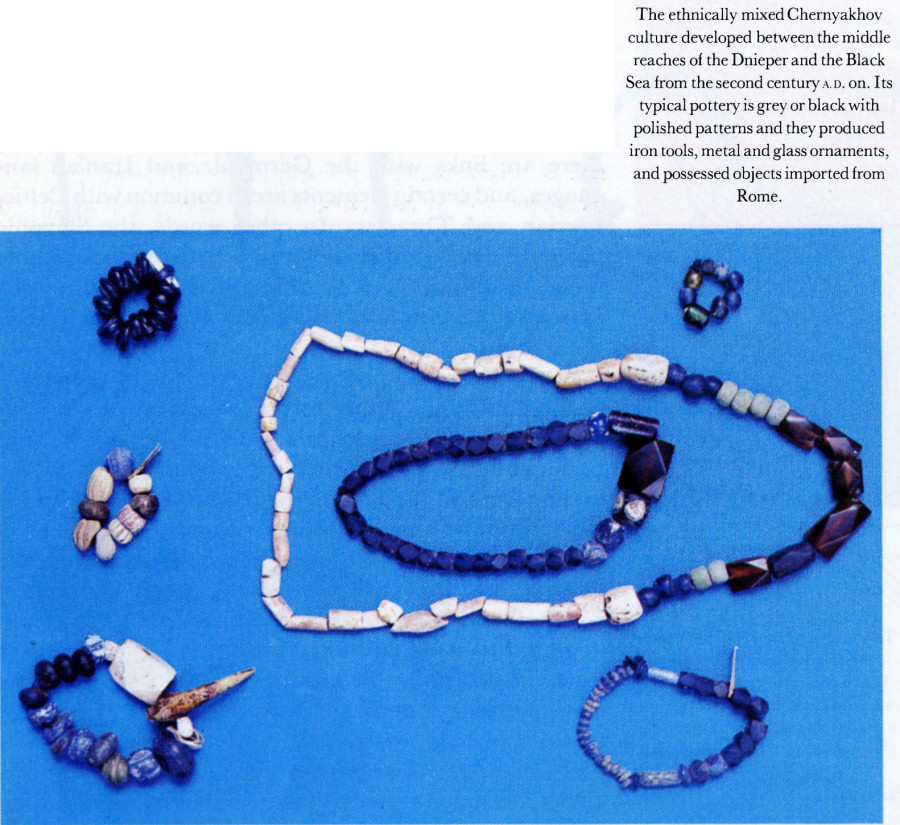
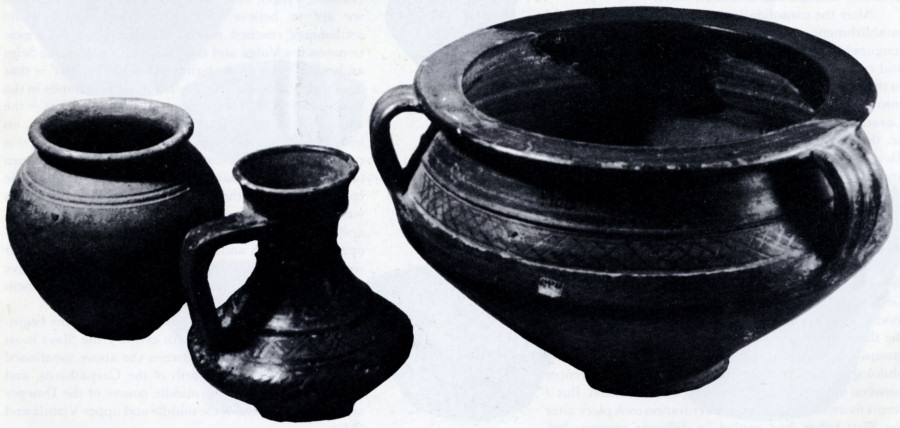
The ethnically mixed Chernyakhov culture developed between the middle reaches of the Dnieper and the Black Sea from the second century A.D. on. Its typical pottery is grey or black with polished patterns and they produced iron tools, metal and glass ornaments, and possessed objects imported from Rome.
A breakthrough in development occurred at the transition from the Bronze to the Iron Age (the eighth to the seventh century B.C.), when the southern Russian steppes were ruled by the Iranian Scythians, who undertook destructive raids far to the west into Central Europe. Their invasion broke up the Lusatian culture, and in the sixth century B.C. it became overlaid by the neighbouring POMERANIAN CULTURE that developed on the south-eastern coast of the Baltic Sea. This must be regarded as the first sign of the differentiation taking
18
![]()
place among the Baltic ethnic units. The merging of the two cultures led to a complex of Bell-Grave burials (the BELL-GRAVE CULTURE); the name was given by Polish archeologists on account of the burial custom in which the urn was covered with a bell-shaped vessel. This new culture existed in the fifth to second centuries B.C., mainly in the river basin of the middle and upper Vistula and Warta, from where it spread west to the middle course of the Oder and east to Volhynia and the Pripyať Forest. In its neighbourhood, along the lower courses of the Oder and Elbe, developed the JASTORF CULTURE associated with Germanic tribes. A little earlier the Cells had appeared on the scene; they advanced into Central Europe from their original home in southern Germany and northern France around the year 400, and some of them reached the areas related to the Slav ethnogenesis — that is, the southern parts of Poland. Proofs of Slav contacts with the Celts can be found both in the language and in certain cultural relics, among them religious practices.
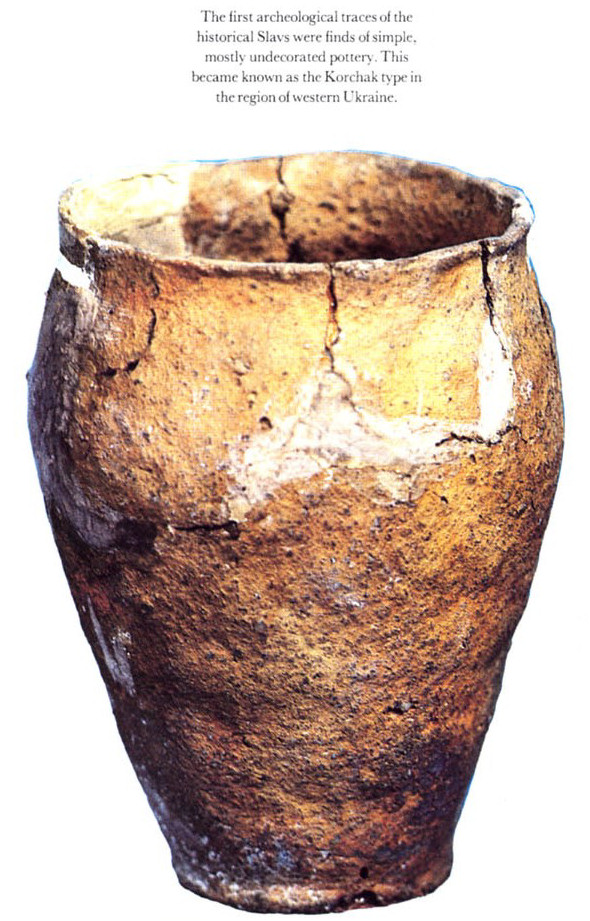
The first archeological traces of the historical Slavs were finds of simple, mostly undecorated pottery. This became known as the Korchak type in the region of western Ukraine.
In the first century B.C. the Bell-Grave culture was replaced by a new cultural unit, the PRZEWORSK CULTURE. In recent years this has been the centre of attention in all efforts to determine Slav ethnogenesis. This culture occupied a somewhat larger domain than its predecessor and spread chiefly south-eastwards along the Carpathians to the upper Dniester and the Tisza valley in Hungary. It flourished throughout the Roman period until the early fifth century A.D., and some scholars, especially in Poland, therefore, identify it with the ancient Venedi. They point out the continuous development from the local roots of the Bell-Grave culture and to certain links between the simple shapes of Przeworsk pottery and the pottery of the early Slavs in the sixth century. On the other hand, the strong Germanic contribution to the Przeworsk culture should not be overlooked, especially in burial rites, pottery, weapons and ornaments, which have an undoubted relationship to the neighbouring Germanic regions to the north-west. It is often considered a bi-ethnic culture documenting the co-existence of Slavic and Germanic tribes, with the Germanic element predominant along the Oder to the west, while the Venedi-Slavic may have been supreme to the east along the Vistula. The only thing that is certain is that the Przeworsk culture was ethnically a mixed one; all other conclusions remain in the sphere of hypothesis.
In dealing with Slav origins one must take into account not merely the territory of southern Poland but likewise the western Ukraine, where a complex development was taking place at a period contemporary with the Bell-Grave and the Przeworsk cultures. This can
19
![]()
likewise be traced to the early Slavs in the sixth century. Geographically one might distinguish three zones in the broad plains of Eastern Europe: 1. the steppes to the south, which were the realm of nomadic tribes, in antiquity mainly the Scythians and the Sarmatians; 2. the forests to the north where widely scattered Finno-Ugric peoples lived (in the eastern parts) and Baltic tribes (to the west): 3. the forest-steppe lands in between with the river basins of the middle Dnieper, Pripyať, Bug and part of the Dniester. This central zone lent itself more favourably to agriculture and should be taken into account in the search for the origins of the Slavs.
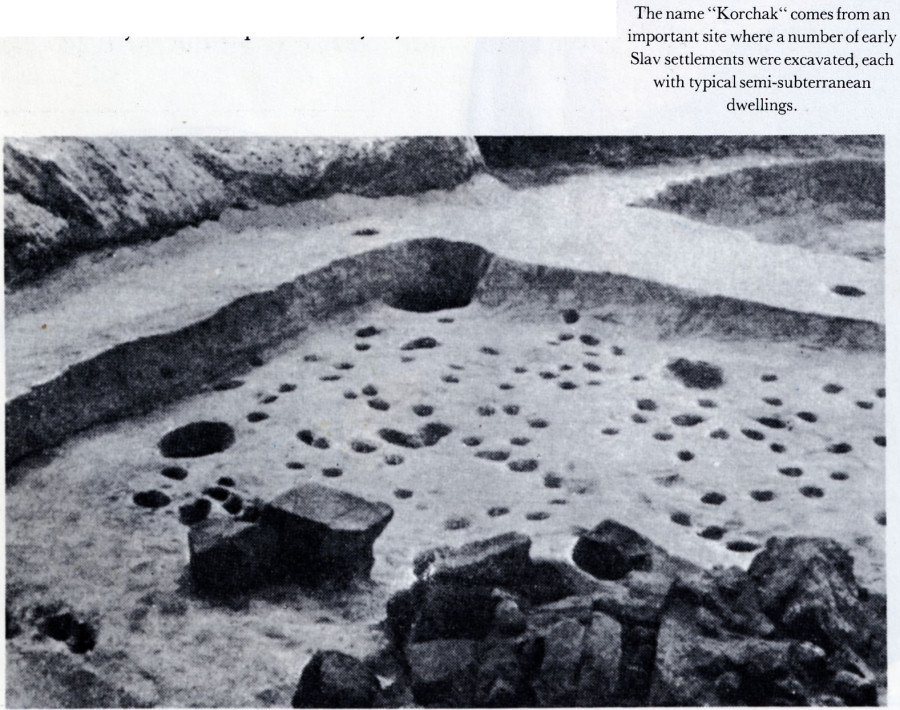
The name "Korchak" comes from an important site where a number of early Slav settlements were excavated, each with typical semi-subterranean dwellings.
In the second century B.C. the ZARUBINTSY CULTURE emerged in the Ukrainian forest-steppe land and partly in the forest regions. Certain Soviet and Polish archeologists consider this already Slavic, others regard it as Baltic or even as representing a transition between the Balts and the Slavs. It belonged to an agricultural people who founded settlements on the protected banks of the rivers and lived in small dwellings, a separate one for each family. They had an outstanding mastery of iron production, even making ornaments. Their material culture shows strong Celtic influences especially in the case of fibulae (clasps), tools and pottery. They buried their dead after cremation and placed the ash in urns or straight into the earth — as did the Slavs later.
A direct identification with the Slavs is, however, disproved by the multifarious origin of the Zarubintsy culture (including Baltic, Scythian, Pomeranian and Bell-Grave elements) and by its relatively early disappearance — basically already by the second century A.D. Only in the north, in the remote forest lands along the upper Dnieper, did certain Zarubintsy traditions survive until the fifth century A.D. (known as the LATE ZARUBINTSY CULTURE or KIEV TYPE). But by that time the territory was occupied chiefly by Baltic tribes.
In the second century A.D. a new cultural group emerged on the southern part of the territory where the Zarubintsy culture was dying away and far beyond it — in the broad steppes of the Ukrainian plains right to the shores of the Black Sea. This culture has been subjected to intensive studies and a very lively exchange of views. It is the CHERNYAKHOV CULTURE, called after an extensive burial ground at Chernyakhov near Kiev, which was uncovered and studied in 1900. To date hundreds of settlements have been discovered scattered mostly in narrow strips along the rivers — sometimes to a distance of 800 metres (about 815 yards) — and a large number of burial grounds with mixed burial rites, both cremations and inhumations, the latter predominant. What is typical is gray or black pottery with polished patterns and of good craftsmanship, but beside it also cruder, unpolished artefacts have been found. The production of iron tools and metal ornaments was of high standard. There were even imports from the Roman Empire, which are very important for dating: coins, amphoras, buckles, little lamps and fine pottery known as terra sigillata.
Most highly debated is the problem of the ethnic membership of the Chernyakhov culture. Since it flourished at a time when the southern Russian steppes were ruled by the Germanic Goths, who penetrated this far from Scandinavia across the south-eastern Baltic regions in the second century A.D., some scholars stress I their particular inclusion. Others have pointed out that the basic elements of this culture had already been established before the arrival of the Goths from a local Scythian-Sarmatian base, on whose territory it existed. But it is further possible to distinguish Thracian, Przeworsk, Zarubintsy and eastern Pomeranian (i.e. Gothic) components, which proves that several ethnic groups linked in one economic and political unit, contributed to the formation of an otherwise more or less unified culture. Even if the process of Slav ethnogenesis seems partly connected with the Chernyakhov culture, so far no definite proofs have been presented that confirm ties between the culture of the early Slavs and the Chernyakhov culture. For life came to a sudden stop in the settlements in the whole territory around A.D. 400; many settlements bear signs of a violent end. This seems to reflect the invasion of the nomadic Huns, who at that time made incursions across the Volga and the Don into the Ukrainian steppe, broke up the Gothic tribal units and set up bases for further raids into the Carpathian Basin. The bearers of the Chernyakhov culture were scattered mainly to the west and south. In the fifth century there then occurred a time gap in settlement in their former territory, which is difficult to bridge to the definitely Slav finds of the sixth century, although a number of scholars have tried to do so. To date only very few early Slavic finds have been made in the region of the Prut, the Dniester and the Bug. They may date from the fifth century and show a certain connection to the Chernyakhov culture, which as a unit disappeared
20
![]()
just before that time. This link-up is only a partial one and cannot, therefore, be considered proof of direct ethnic continuity, only a reflection of how the remaining Chernyakhov population became assimilated into the newly emerging ethnic group.
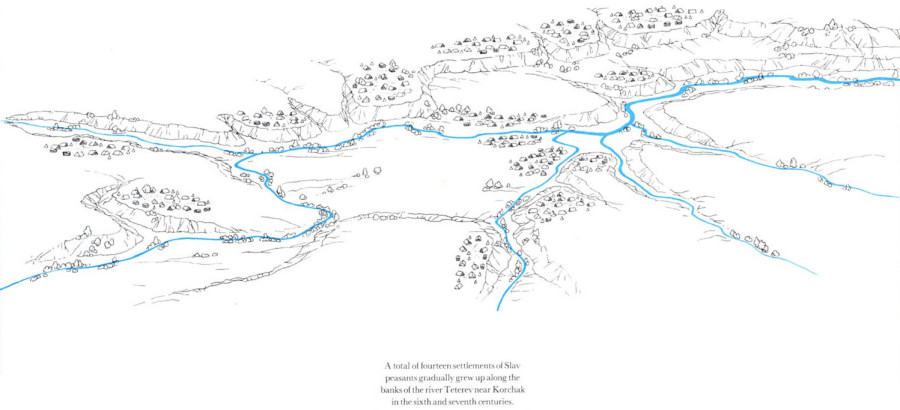
A total of fourteen settlements of Slav peasants gradually grew up along the banks of the river Teterev near Korchak in the sixth and seventh centuries.
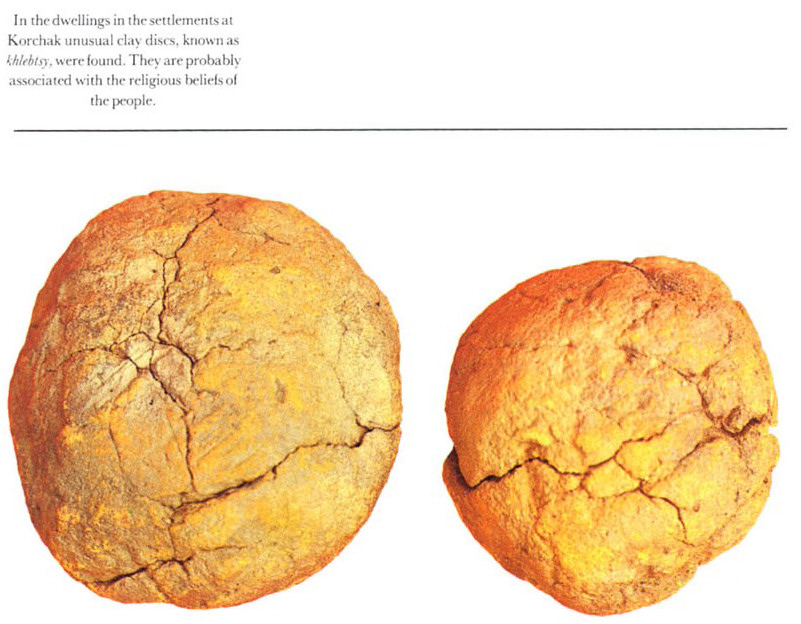
In the dwellings in the settlements at Korchak unusual clay discs, known as khlebtsy, were found. They are probably associated with the religious beliefs of the people.
We shall now sum up this brief survey of the history, according to the early archeological evidence of the territory where the early Slavs settled from the sixth century on. It is typical of the entire region between the Oder. Vistula, Dniester and Dnieper that by the end of the fourth century and at the latest in the early fifth century all developed cultures with Late Roman traditions vanished: that is, the Chernyakhov, Late Zarubintsy (Kiev type) and the Przeworsk. Instead, after a certain gap in time, a new culture emerged which has partial connections with the preceding ones but does not tie up with any of them directly. On the contrary, it represented quite a novel phenomenon on this territory, where previous cultural elements tended to merge.
Let us take a closer look at the culture of the early Slavs. It differed from that of their predecessors mainly in its simplicity, comprehensible if we take into account that it was formed by a people on the move, in the whirlpool of the big tribal migration, which did not leave time for richer cultural development. It would seem that in its earliest phase it took shape in the lowlands between the eastern Carpathians and the rivers Pripyať and middle Dnieper, where, in the fifth to seventh centuries, we find the KORCHAK TYPE, called after Ukrainian sites in the Zhitomir region. These finds are concentrated in the river basin of the Pripyať, mainly along its southern tributaries; eastwards they reach as far as the Dnieper, westwards to the Western Bug and south to the Dniester. The relatively small settlements lie along low river banks. They arc often grouped in a nest of three to four settlements in close proximity to each other. Typical semi-subterranean dwellings of a square ground plan (average 4 m x 4 m, about 4.5 yds x 4.5 yds) served as shelters everywhere, each with a stone oven. The dead were cremated and the remains placed in simple hand-made and undecorated urns buried below tumuli or simply in the ground. Finds of the Korchak type can be dated by the weapons and cast bronze or silver ornaments, such as clasps, belt trimmings, pendants and armbands known from the fifth to seventh century southern Russian treasures. Byzantine coins from the sixth century were brought lo light in the hill-fort at Zimno.
21
![]()
The western equivalent of the Korchak type is the PRAGUE TYPE, with finds covering the southern parts of Poland and East Germany and the entire area of Czechoslovakia, with occasional finds in the Danube basin of Austria. Of these only the southern part of Poland and perhaps the eastern tip of Slovakia may be counted as the original homeland of the Slavs. The settlement of the rest of the territory already reflects Slav expansion.
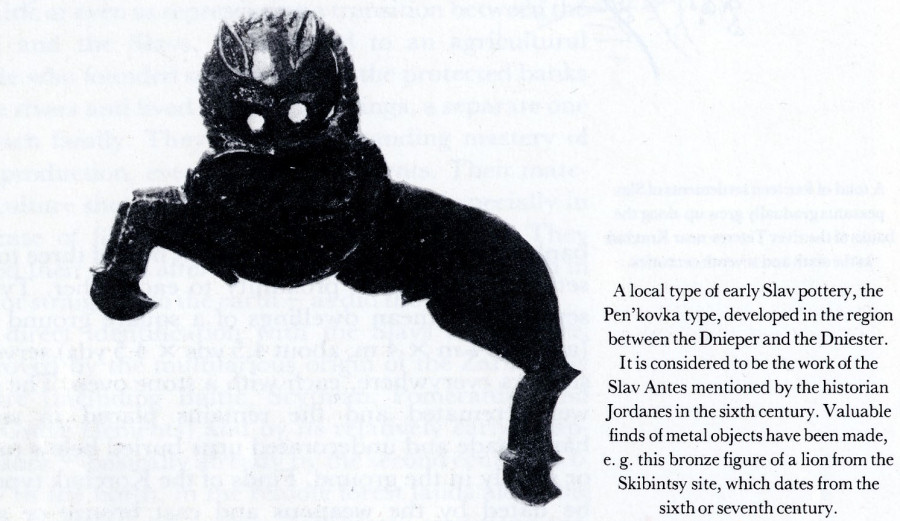
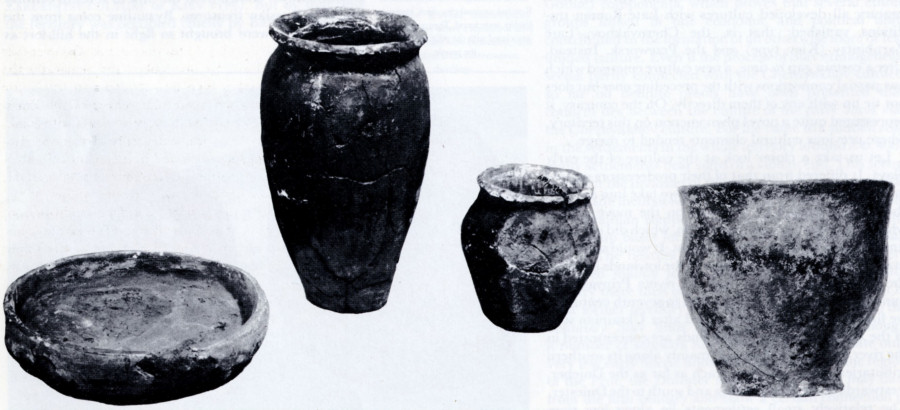
A local type of early Slav pottery, the Pen'kovka type, developed in the region between the Dnieper and the Dniester. It is considered to be the work of the Slav Antes mentioned by the historian Jordanes in the sixth century. Valuable finds of metal objects have been made, e. g. this bronze figure of a lion from the Skibintsy site, which dates from the sixth or seventh century.
At the turn of the fourth to fifth century far-reaching changes were taking place on the territory of the Przeworsk culture in southern and central Poland, caused by the incursions of the Huns into the Carpathian Basin. The settlements and burial grounds of the Przeworsk type disappear, the Roman tradition survived only in isolation into the first half of the fifth century when it merged with Hun influences spreading from the Carpathian Basin. All this vanished when the Hun dominance came to an end in 455. Then the Slavs were able to advance from the east into this region bringing with them their simple, unornamented pottery, semi-subterranean dwellings and burial by cremation. Few aids exist that might help in dating these finds, but there is every reason to suppose that the Slav settlement occurred in the second half of the fifth century.
The third region associated with the process of Slav ethnogenesis lay between the lower Dnieper and the Dniester and in the river basin of the Southern Bug. According to a site found in 1955 the archeologists appended the name PEN'KOVKA TYPE to this group. Excavations brought to light five settlements spread over seven kilometres (about four miles) along the banks of the river Tiasmin. In character, choice of terrain and type of dwellings, they were of a similar type as the settlements of the Korchak group. Likewise the handmade, unornamented pottery is close to the Korchak group but differs from it by the predominance of bi-conic shapes that are strongly reminiscent of similar finds in the forest regions of the north. Among the numerous metal objects are valuable fibulae which facilitate dating into the sixth to seventh century. But strong links with the preceding Chernyakhov culture, which vanished at the turn of the fourth to the fifth century, point to an earlier origin of the Pen'kovka type. These two types have even been found side by side. The contacts with the remnants of the Chernyakhov population and the assimilation of their culture must have taken place in the fifth century. Some scholars are, therefore, of the opinion
22
![]()
that the people who created the Pen'kovka type were survivors of the original Iranian population, probably Sarmatians, who adapted to Slav ways and were called Antes (or Anti) in the historic records of the sixth century. Jordanes, for example, distinguishes them from the Sclaveni, probably pure Slavs, but stresses that they likewise spoke a Slavonic tongue. Their mighty union of tribes succumbed to the Avars in the early seventh century, but the culture survived longer and the spread of finds to the south indicates that these Slavs participated in the expansion to the Balkans.
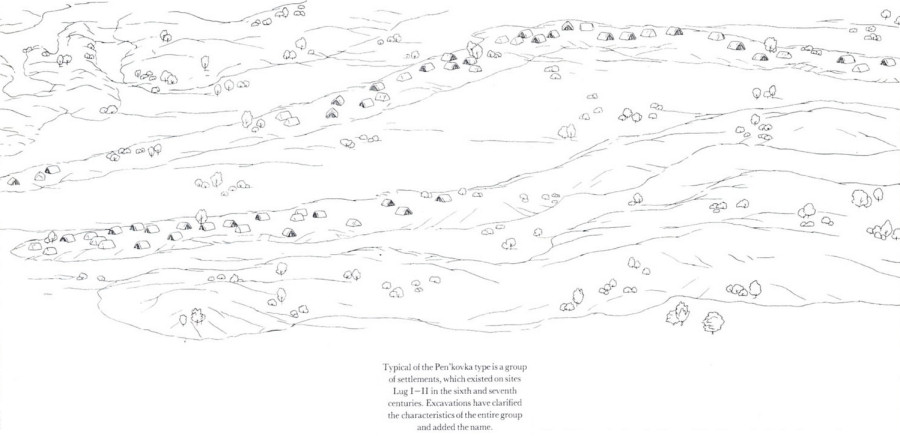
Typical of the Pen'kovka type is a group of settlements, which existed on sites Lug I—II in the sixth and seventh centuries. Excavations have clarified the characteristics of the entire group and added the name.
Archeologists arc at a loss in regard to another cultural group that existed in the forest regions of ihe upper Dnieper, roughly today's Byelorussia and the river basin of the Desna as far almost as Kiev. According to two important finds it is usually called the KOLOCHIN- TUSHEMLYA TYPE. These people lived in small settlements along the river banks, using semi-subterranean dwellings or houses built at ground level supported on posts. They made simple pottery, slightly different in shape from the Korchak-Prague type: conical, bi-conical, gently profiled, etc. The women wore bronze ornaments of the Baltic type inlaid with enamel. Their garments were held together with one fibula, they wore bracelets with widening ends and spun wool with the aid of bi-conical spindles with a large hole in the centre. The men wore belts with gilt bronze ornaments, and their weapons included bow and arrow and spears. The dead were cremated and the remains were placed in pits, sometimes in urns or below tumuli.
In view of the similarity in features of the general cultural model, scholars have put forward the ideas of a possible connection between the Kolochin-Tushcmlya type and the Slavs. They point out that certain elements spread to the south, the area where Pen'kovka type finds associated with the Slav Antes were made. On the other hand, it should not be overlooked that basically the Kolochin-Tushcmlya type had its roots in the Baltic Iron Age cultures with some influences of the Zarubintsy culture (shapes of pottery, ornaments with inlaid enamel). It is, furthermore, widely spread over a territory where philologists have found Baltic, names of watercourses; it did not continue to develop but was overlaid, in the eighth to ninth century, by the influx of the colonizing Slavs. They brought a different culture from the south, the area of the Korchak and Pen'kovka types. It is now thought that the inhabitants of the upper Dnieper basin, where the Kolochin-Tushemlya culture grew up in the fifth to eighth century, were most likely Baltic or at best mixed Balto-Slavic in origin.
23
![]()
4. WHEN DID THE EMERGENCE OF THE SLAVS TAKE PLACE?
We have summed up the archeological findings in the hypothetical homeland of the Slavs, from the first reports by ancient writers to the period of the migration of nations when the foundations of the ethnic map of Europe were laid. Despite the inevitable simplification this brief survey indicates how complicated a process the emergence of the Slavs was. In many regards scholars are still in the dark, even though they have gathered up a considerable quantity of material to uphold their arguments.
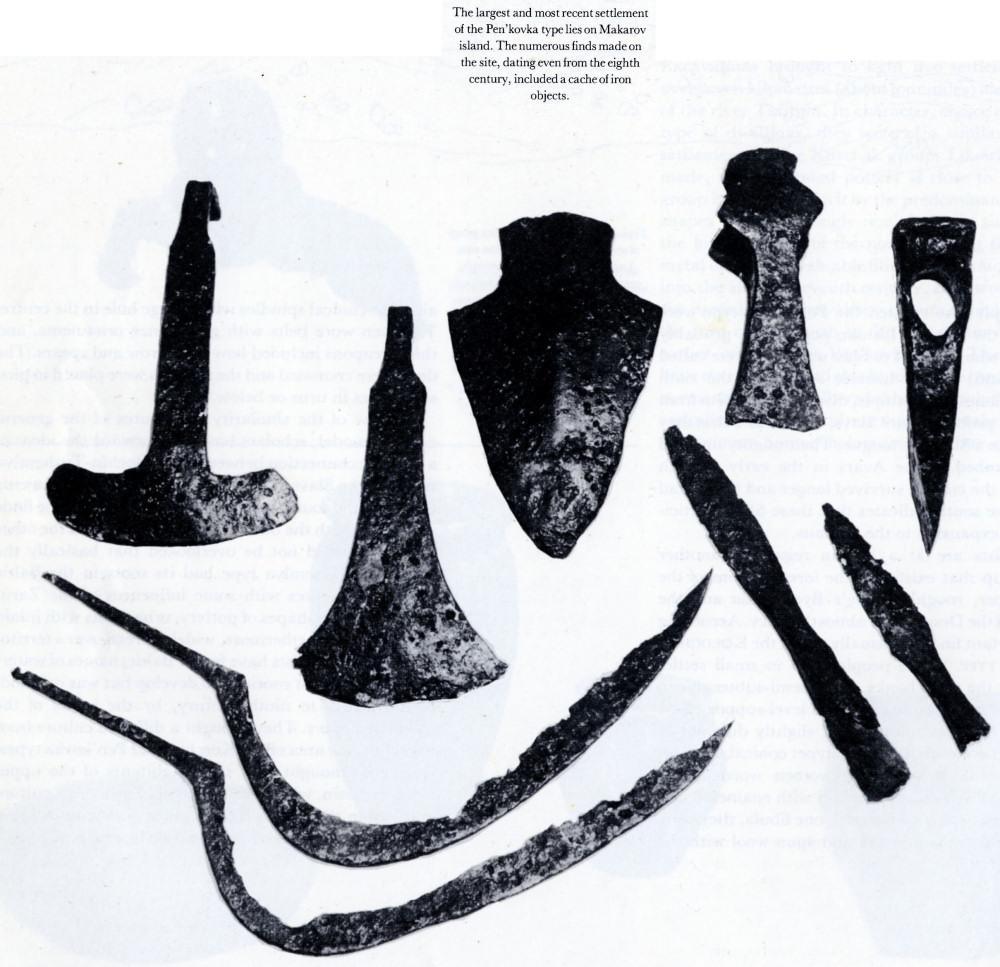
The largest and most recent settlement of the Pen'kovka type lies on Makarov island. The numerous finds made on the site, dating even from the eighth century, included a cache of iron objects.
The following questions still require clarification: how to decide between mutually contradictory facts, how to make them fit the mighty, historically proven appearance in the sixth to seventh century of the Slavs, a people who had been completely unknown to the civilized world until that time? How to explain the fact that an ethnic unit for which, in the first half of the first millennium A.D., there was no place historically or archeologically — on which all scholars might agree — managed suddenly to flood a considerable part of the European continent in the course of two or three centuries? How is it possible that such a mighty section of European peoples, who, from the sixth century on, emerged in linguistic and cultural unity, should until then escape the attention of the entire civilized world of the Greeks and Romans, who were otherwise so well informed about far more remote regions? It is equally- remarkable that among the large Indo-European branches, such as the Germans, Celts, Illyrians, Thracians,
24
![]()
Dacians, Scythians, Sarmatians, etc., the Slavs were the only ones who were known by name only after the fall of the Roman Empire. The view that a mere change of name, that is, from the Venedi to the Slavs, took place is not satisfactory given the comparative stability of names of the other large ethnic groups. While we can trace archeologically the development of the Germanic tribes, the Balts, Celts and Iranians, far back into antiquity, the Slavs vanish without a trace before the fifth to sixth century. Very little help is rendered by the efforts of certain archeologists who try to show the overlaying of early Slavonic culture upon the cultures of the Roman period. This refers only to marginal features and not to the culture as such. Equally unsatisfactory are propositions as to a change in the cultural model during the critical historic situation of the migration of nations, e.g. from the model of the Przeworsk culture to a deviating model of Early Slavonic. This does not explain the time gap between the disappearance of the old and the birth of the new culture.
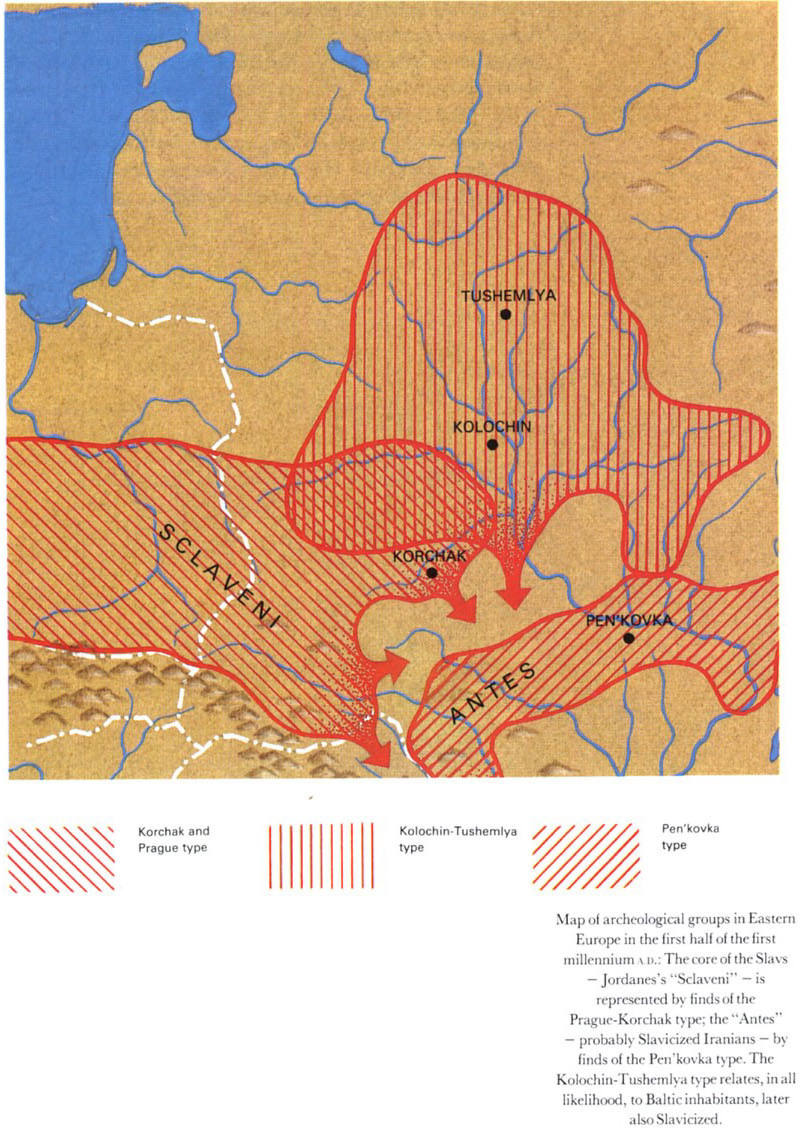
Map of archeological groups in Eastern Europe in the first half of the first millennium A.D.: The core of the Slavs — Jordanes's "Sclaveni" — is represented by finds of the Prague-Korchak type; the "Antes" — probably Slavicized Iranians — by finds of the Pen'kovka type. The Kolochin-Tushemlya type relates, in all likelihood, to Baltic inhabitants, later also Slavicized.
There is only one highly likely, if hypothetical, explanation for these contradictory historical, archeological and linguistic facts: the Slavs as a cultural and ethnic unit, in the form known from the sixth century A.l) on, did not exist in antiquity. They underwent a complex process of ethnogenesis that reached its culmination in the fourth to fifth century and was completed just before the great migration began. This might even be regarded as a sign that the entire process had matured by then. The difficulties that arise in trying to determine ethnically the cultural groups of the Roman period living between the Oder and the middle Dnieper (Przeworsk, Chernyakhov, Zarubintsy) derive from the fact that in marginal areas they all contributed to the birth of a new ethnic unit, a process that the Celts and Germans had undergone long before. Of all the members of the large Indo-European family the Slavs were the last to emerge. And for that reason their arrival in history took place with such youthful strength. Only if that is so can we understand how, all of a sudden, they emerged in the sixth century as a unified linguistic group and how, by contrast to the Germanic groups, who underwent a much longer development, they became differentiated in language relatively late — between the ninth and the thirteenth century. To this day they remain comparatively closer to each other than do the nations of the other Indo-European branches.
The ancient Venedi must have played an important role in this ethnogenetic process even if one cannot place an equation mark between them and the early medieval Slavs. Their ethnical character remains unclear (Illyrians, Cello-Germans, or more likely Balto-Slavs — a transition between the Balts and the Slavs?). In fact, they probably were no more than an organizational component that later merged with its economic substratum and represented therefore a mere developmental pre-stage of the early Slavs. That would help us to understand why Tacitus was at a loss to say whether the Venedi were part of the Germanic tribes or the Sarmatians.
The new ethnic group emerged along the fringes of several large Indo-European groups confirmed in the records. There were the Balts to the north, the Germans to the west, the Iranian Sarmatians to the east and, to a lesser extent, in view of certain linguistic relations, even the Celts, Thracians and perhaps the Illyrians to the south. Closest in language to them were the Balts, whose share in the ethnogenetic process of the Slavs was most pronounced. Recent research has shown that Baltic names of watercourses can be found surprisingly far south and east, even south of the Pripyať, that is, the domain of the Slavic Korchak type of the fifth to seventh centuries. They occur over an infinitely larger area than the river names of definitely Slavonic origin. This fact strongly contrasts with the spread of Slav and Baltic settlements formed, according to archeological evidence, in the eighth to tenth centuries. It indicates the great importance of the Baltic component in the origin of the Slav ethnic group.
25
![]()
The one Slavonic language, documented in records of the sixth to ninth centuries, can be considered an expression of the completion of the process of integration within the region touching on the Balts, Germans and Iranians (with a major Baltic share), which we must seek somewhere between the middle Dnieper, Pripyať, upper Dniester, Vistula and Oder. All linguistic and archeological facts point to that region. Archeologically this is reflected in the content and extent of three adjacent cultures which partly interlinked: the Przeworsk, Chernyakhov and Late Zarubintsy, to which each of these above mentioned ethnic components contributed. Of particular importance in this regard is the eastern part of the Przeworsk, the north-western part of the Chernyakhov and the southern part of the Late Zarubintsy cultures (Kiev type). The disappearance of these cultures in the fourth to fifth century is a sign of the culmination of that ethnic differentiation and cultural and linguistic integration. The actual Slavs (Sclaveni) then made their appearance in the fifth to sixth century, confirmed by finds of the Prague-Korchak type, a unified cultural unit reflecting an integrated ethnic unit. Once the Slav expansion was complete and new settlements had been occupied, a new process of disintegration set in which led to the emergence of the three main groups of Slavs — Eastern, Western and Southern — and later, in the Middle Ages, to the origin of nations.
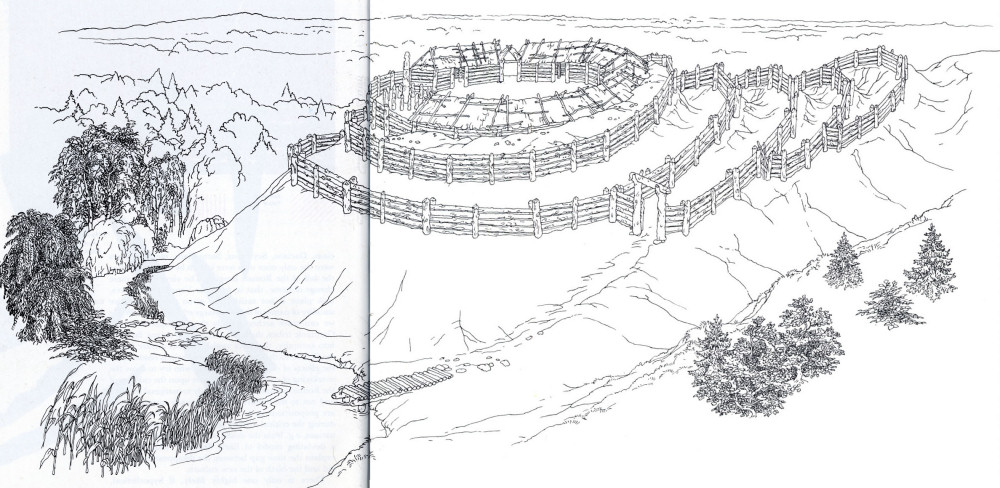
The cultural group of Kolochin-Tushemlya was widespread in the wooded regions along the upper Dnieper in the fifth to eighth century. The inhabitants were probably of Baltic or temporary Balto-Slavic origin. One of their main centres was the hill-fort of Tushemlya where there was a pagan shrine. Excavations have enabled the archeologists to attempt its approximate reconstruction.
In other words, the Slavs are the youngest section of the European peoples. They appear on the scene only after the middle of the first millennium A.D. Without such a conclusion one cannot explain the relative
26
![]()
linguistic unity of the Slav people in the early Middle Ages, whereby they differed strikingly from other, linguistically highly differentiated contemporary ethnic groups (for example, the Germans), and their sudden emergence in history and archeology, from the sixth century on. This could happen only as a consequence of a complex ethnogenetical process, which took place in the first half of the first millennium A.D. It involved a certain section of the Baltic tribes living in inland Eastern Europe, where, until the Roman period, they had formed a Balto-Slavic unit. They then became individualized by closer contacts with the neighbouring Germanic and Iranian regions. The outcome was the early Slavs, who later set out on the march to find new homes in Europe. But that is a story to be told in the next chapter.